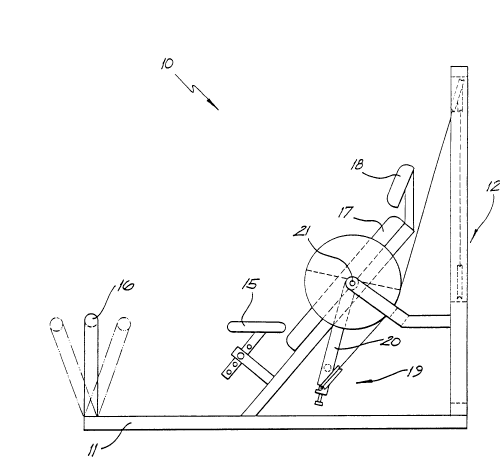Note: Claims are shown in the official language in which they were submitted.
- 5 -
THE EMBODIMENTS OF THE INVENTION IN WHICH AN EXCLUSIVE PROPERTY
OR PRIVILEGE IS CLAIMED ARE DEFINED AS FOLLOWS:
l. An exercise machine comprising:
a base frame;
an arm assembly mounted on the frame and including, a lever
pivotally mounted on said frame for pivoting movement about a first axis,
a movement transfer member, mounted on said lever for angular movement
relative thereto about a second axis, handle means on said member to be
gripped by a user to apply forces thereto to cause pivoting of said lever
and angular movement of said member;
means to resist movement of said levers; and
support means to position the user s body so that said axes are
positioned to be coaxial with normal pivoting axes of the user s body.
2. The machine of claim l, wherein said support means and said
first lever are arranged so that said first axis extends in a direction
transverse of the user and said movement transfer member is a shaft
mounted for rotation about said second axis, said second axis being
generally normal to said first axis, and wherein said machine further
includes a handle fixed to said shaft to be gripped by a user to cause
rotation-thereof by rotation of the user s wrist about the longitudinal
axis of the user s lower arm.
3. The machine of claim 2, wherein said shaft is mounted for
longitudinal movement along said second axis.
4. The machine of claim 2, wherein the resistance means includes
a first resistance means to apply a resistance force to movement of said
lever, and a second resistance means to apply a resistance force to the
rotation of said shaft.
5. The machine of claim l, wherein said support means is arranged
relative to said first axis so that said first axis extends generally
transverse of the user, and said movement transfer member is a second
lever pivotally mounted on said first lever for rotation about said
second axis.
6. The machine of claim 5, wherein said second axis is normal to
said first axis.
7. The machine of claim 5, wherein said second axis is parallel
to said first axis but spaced therefrom.
8. The machine of claim 5, wherein the resistance means includes
a first resistance means to resist movement of said first lever, and
second resistance means to resist movement of said second lever.
LMM/513t
- 6 -
9. The machine of claim 8, further including forced transfer
means coupling said first lever with said resistance means to vary the
force applied to said first lever in accordance with its angular
deflection.
10. An exercise machine substantially as hereinbefore described
with reference to Figures 1 to 5 of the accompanying drawings, or with
reference to Figure 6 or Figure 7 of the accompanying drawings.
